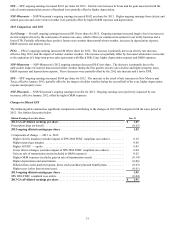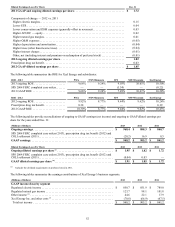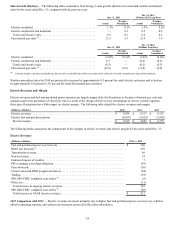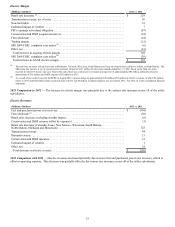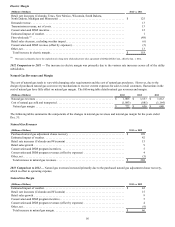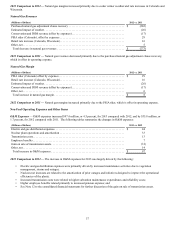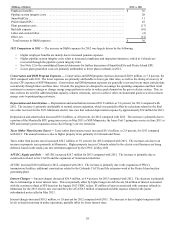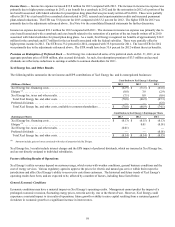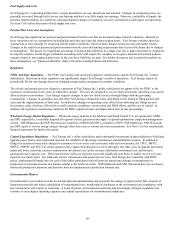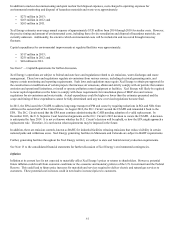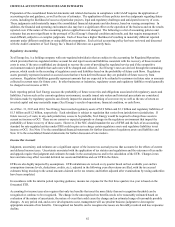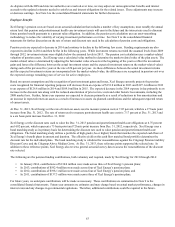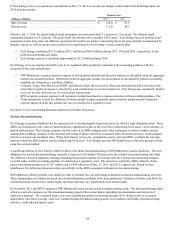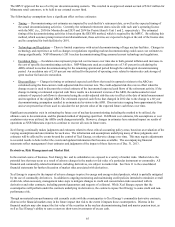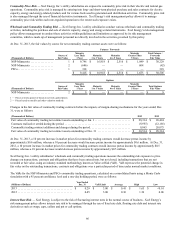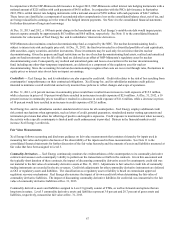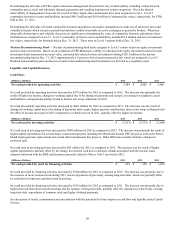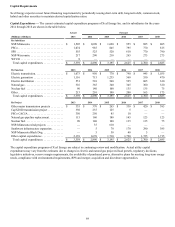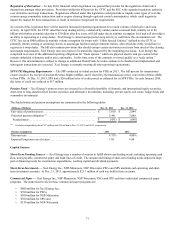Xcel Energy 2013 Annual Report Download - page 79
Download and view the complete annual report
Please find page 79 of the 2013 Xcel Energy annual report below. You can navigate through the pages in the report by either clicking on the pages listed below, or by using the keyword search tool below to find specific information within the annual report.61
In addition to nuclear decommissioning and spent nuclear fuel disposal expenses, costs charged to operating expenses for
environmental monitoring and disposal of hazardous materials and waste were approximately:
• $275 million in 2013;
• $263 million in 2012; and
• $265 million in 2011.
Xcel Energy estimates an average annual expense of approximately $320 million from 2014 through 2018 for similar costs. However,
the precise timing and amount of environmental costs, including those for site remediation and disposal of hazardous materials, are
currently unknown. Additionally, the extent to which environmental costs will be included in and recovered through rates may
fluctuate.
Capital expenditures for environmental improvements at regulated facilities were approximately:
• $517 million in 2013;
• $255 million in 2012; and
• $48 million in 2011.
See Item 7 — Capital Requirements for further discussion.
Xcel Energy’s operations are subject to federal and state laws and regulations related to air emissions, water discharges and waste
management. These laws and regulations regulate air emissions from various sources, including electrical generating units, and
impose certain monitoring and reporting requirements. Such laws and regulations may require Xcel Energy to obtain pre-approval for
the construction or modification of certain projects that increase air emissions, obtain and strictly comply with air permits that contain
emission and operational limitations, or install or operate pollution control equipment at facilities. Xcel Energy will likely be required
to incur capital expenditures in the future to comply with these requirements for remediation plans of MGP sites and various
regulations for air emissions and water intake. Actual expenditures could be higher or lower than the estimates presented and the
scope and timing of these expenditures cannot be fully determined until any new or revised regulations become final.
In 2011, the EPA issued the CSAPR to address long range transport of PM and ozone by requiring reductions in SO2 and NOx from
utilities in the eastern half of the United States. In August 2012, the D.C. Circuit vacated the CSAPR and remanded it back to the
EPA. The D.C. Circuit stated that the EPA must continue administering the CAIR pending adoption of a valid replacement. In
December 2013, the U.S. Supreme Court heard oral arguments on the D.C. Circuit’s 2012 decision to vacate the CSAPR. A decision
is anticipated by June 2014. It is not yet known whether the D.C. Circuit’s decision will be upheld, or how the EPA might approach a
replacement rule. Therefore, it is not known what requirements may be imposed in the future.
In addition, there are emission controls, known as BART, for industrial facilities releasing emissions that reduce visibility in certain
national parks and wilderness areas. Xcel Energy generating facilities in Minnesota and Colorado are subject to BART requirements.
Further, generating facilities throughout the Xcel Energy territory are subject to state and federal mercury reduction requirements.
See Note 13 to the consolidated financial statements for further discussion of Xcel Energy’s environmental contingencies.
Inflation
Inflation at its current level is not expected to materially affect Xcel Energy’s prices or returns to shareholders. However, potential
future inflation could result from economic conditions or the economic and monetary policies of the U.S. Government and the Federal
Reserve. This could lead to future price increases for materials and services required to deliver electric and natural gas services to
customers. These potential cost increases could in turn lead to increased prices to customers.


